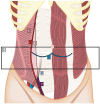Spigelian hernia: current approaches to surgical treatment-a review
- PMID: 34665343
- PMCID: PMC9684297
- DOI: 10.1007/s10029-021-02511-8
Spigelian hernia: current approaches to surgical treatment-a review
Abstract
Background: Spigelian hernias (SpH) belong to the group of eponymous abdominal wall hernias. Major reasons for diagnostic difficulties are its low incidence reaching maximum 2% of abdominal wall hernias, a specific anatomical localization with intact external oblique aponeurosis covering the hernia sac and non-constant clinical presentation.
Methods: A literature review was completed to summarize current knowledge on surgical treatment options and results.
Results: SpH presents a high incarceration risk and therefore should be operated upon even if the patient is asymptomatic. Both laparoscopic and open repair approaches are validated by current guidelines with lesser postoperative complications and shorter hospital stay in favour of minimally invasive surgery, regardless of the technique used. Overall recurrence rate is very low.
Conclusion: All diagnosed SpH should be planned for elective operation to prevent strangulated hernia and, therefore emergency surgery. Both open and laparoscopic SpH treatment can be safely performed, depending on surgeon's experience. In most cases, a mesh repair is generally advised.
Keywords: Hernia surgery; Minimally invasive surgery; Review; Spigelian hernia; Surgical anatomy.
© 2021. The Author(s).
Conflict of interest statement
The authors declare that they have no competing interest.
Figures



Comment in
-
Spigelian hernia: current approach to surgical treatment-peculiarities in this rare condition.Hernia. 2022 Dec;26(6):1707-1708. doi: 10.1007/s10029-022-02678-8. Epub 2022 Sep 14. Hernia. 2022. PMID: 36104475 No abstract available.
Similar articles
-
Outcomes After Spigelian Hernia Repair: A Nationwide Database Study.World J Surg. 2023 May;47(5):1184-1189. doi: 10.1007/s00268-023-06923-8. Epub 2023 Feb 7. World J Surg. 2023. PMID: 36749361
-
Interposition of the omentum and/or the peritoneum in the emergency repair of large ventral hernias with polypropylene mesh.Int J Surg. 2014;12(6):578-86. doi: 10.1016/j.ijsu.2014.04.009. Epub 2014 Apr 30. Int J Surg. 2014. PMID: 24793234
-
Laparoscopic intraperitoneal mesh repair of Spigelian hernia: A case report.Asian J Endosc Surg. 2015 Nov;8(4):477-9. doi: 10.1111/ases.12205. Asian J Endosc Surg. 2015. PMID: 26708590
-
Spigelian hernia: Our total extraperitoneal approach and a systematic review of the literature.Asian J Endosc Surg. 2021 Jul;14(3):529-539. doi: 10.1111/ases.12912. Epub 2021 Jan 3. Asian J Endosc Surg. 2021. PMID: 33393194
-
Spigelian hernias in the adult population: a systematic review of the literature.Langenbecks Arch Surg. 2024 Jul 29;409(1):230. doi: 10.1007/s00423-024-03427-4. Langenbecks Arch Surg. 2024. PMID: 39073648
Cited by
-
Outcomes After Spigelian Hernia Repair: A Nationwide Database Study.World J Surg. 2023 May;47(5):1184-1189. doi: 10.1007/s00268-023-06923-8. Epub 2023 Feb 7. World J Surg. 2023. PMID: 36749361
-
Spigelian Hernia: A Rare Ventral Hernia.Cureus. 2024 Feb 29;16(2):e55209. doi: 10.7759/cureus.55209. eCollection 2024 Feb. Cureus. 2024. PMID: 38558702 Free PMC article.
-
Hidden in plain sight: abdominopelvic pain unveiling a Spigelian hernia containing ovary and fallopian tube.J Surg Case Rep. 2025 Jan 9;2025(1):rjae548. doi: 10.1093/jscr/rjae548. eCollection 2025 Jan. J Surg Case Rep. 2025. PMID: 39802337 Free PMC article.
-
Giant spigelian hernia in a middle-aged female: The importance of intraoperative ultrasonography for hernia localization-Case report.SAGE Open Med Case Rep. 2024 Apr 24;12:2050313X241249099. doi: 10.1177/2050313X241249099. eCollection 2024. SAGE Open Med Case Rep. 2024. PMID: 38665933 Free PMC article.
-
Spigelian Hernia: A Clinical Case Report.Cureus. 2023 Oct 6;15(10):e46589. doi: 10.7759/cureus.46589. eCollection 2023 Oct. Cureus. 2023. PMID: 37933366 Free PMC article.
References
-
- van den Spiegel A (1627) De humani corporis fabrica libri decem. Evangelista Deuchinus, Venice
-
- Klinkosh JT (1764) Divisionem herniarum novamgue hernias ventralis specimen proponit. Dissertationum Medicorum, p 184
Publication types
MeSH terms
LinkOut - more resources
Full Text Sources

